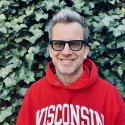‘Community’ encourages contribution to inclusive campus
A unique problem about crises is that they often hold valuable lessons.
“I asked myself what kinds of things create community and I came up with a sad answer. Crisis creates community,” says Bernice Durand, associate vice chancellor for diversity and climate. “How do we generate and sustain that bonding, which grows out of the thought, empathy and generosity of a crisis?”

Members of the Alpha Phi Alpha fraternity perform several step dance routines during a luncheon held in the Memorial Union’s Great Hall as part of the sixth annual Plan 2008 campus diversity forum. Stepping, which can be traced back to African tribal dancing, is a performance of solidarity and power and combines spoken word and body percussion to create beats and tell stories.
Related stories:
Bazzell shares background, importance of diversity
Durand posed this query among many other questions to faculty, staff and students last week at the Multicultural Campus Forum on Creating Community held at the Memorial Union. The daylong forum included thoughts from Chancellor John Wiley and Provost Peter Spear as well as personal reflections from Vice Chancellor Darrell Bazzell, small-group sessions, and performances by the Theatre for Cultural and Social Awareness students and poet Katrina Flores.
The forum highlighted Plan 2008 goals for this academic year and beyond. The main focus includes improving the classroom and workplace climate through diversity and inclusive education.
“We want to defeat racism and other ‘isms’ through inclusive and diverse education and community building,” says Durand. “We want to develop and sustain academic, professional and personal support for everyone on campus. We want to build on what works.”
“Inclusive campus communities are the hallmark of a positive campus climate,” adds professor LD Oakley, chair of the Diversity Oversight Committee. “Inclusive campus communities grow diversity.”
In addition to inclusive education, forum participants and facilitators focused on individual responsibility, accountability and leadership as ways to create community before a crisis hits.
“Leadership is a critical component. But in my mind leadership does not stop at the outer doors of Bascom Hall,” Bazzell says. “Leadership needs to exist all across this campus. Throughout our student body population, throughout our staff and faculty. All of us need to be in this movement.”
Ryan Quintana, a history doctoral candidate, participated this summer in a faculty-led bus tour of the Santa Fe Trail. In addition to the educational benefits he received, he gained something much more personal: He was able to see the area where his father grew up.
“It made things a lot more real,” Quintana says. “These journeys should be part of everyday curriculum. We’re always encouraging students to think outside the box, but with these [trips], you actually drive them outside the box.”
Faculty, students and staff hope that more awareness in programs such as these and others such as the PEOPLE program and the Leadership Institute will help everyone on campus to become leaders in creating community. Students, faculty and staff can also check out http://www.diversity.wisc.edu, which was unveiled at the forum.
The Creating Community Web site has features, profiles, links and provides a venue for readers to find ways in which they can help create community on campus.
“How are you contributing to campus community?” Durand says. “We don’t want to wait for and we don’t need to wait for an urgent crisis to pull us together.”
Tags: diversity



